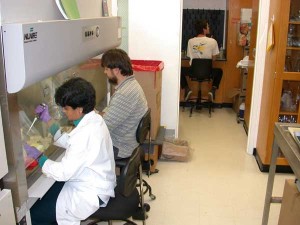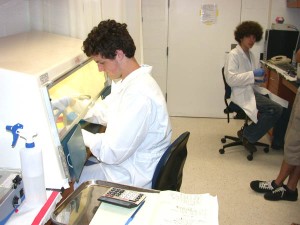MADL is a state-of-the-art facility (1450 sq ft) built by the Marine Diseases and Pathology Research Consortium partners in 2002 to serve as a marine diagnostic facility for New York State and as a center of marine disease research.
Major instruments equipping the lab include:
- 2 flow cytometers (1 Attune Cytpix: 4 lasers, 14 colors, equipped wit a fast-speed camera, and 1 BD FACSCalibur: 2 lasers, 4 colors, including sorting capabilities)
- 1 quantitative Real-Time PCR machine (Applied Biosciences QuantStudio 6)
- 3 standard PCR machines (Eppendorf Mastercycler Gradient)
- 1 FPLC (Fast Protein Liquid Chromatography, Bio-Rad)
- 1 96-well plate reader (Perkin Elmer) with fluorometry, spectrophotometry and luminometry abilities (equipment shared with Dr Anne McElroy)
- 1 Nanodrop spectrophotometer and 1 Qubit fluorometer
- 1 Dynatech Laboratories spectrophotometer
- Bioinformatics resources housed in the lab include a HP Workstation equipped with CLC Genomics Workbench and a variety of open source programs for genomic research (the MADL also maintains full access to High Performance Computing clusters maintained at Stony Brook University -SeaWulf- and elsewhere -XSEDE)
The lab is equipped with necropsy facilities and state of the art Nikon microscopy equipment for episcopic and diascopic dissecting, and fluorescence, Nomarski (DIC), phase, inverted (Nikon Eclipse TE-2000S) and upright (Nikon Eclipse TE-200) compound microscopy with digital image capture and analysis capability on all microscopes (Spot Insight QE camera that is connectable on all microscopes, interfaced with a Dual Core computer loaded with 2 image analysis software: Image Pro and Image/J).
The laboratory is also equipped with a spacious Class II biosafety cabinet for aseptic work, a range of incubators (4 total), as well as many smaller instruments appropriate for cellular and physiological studies (3 centrifuges, 1 cytospin, 2 chemical hoods, 3 refrigerators, one -20C freezer, and four -80C freezers), as well as equipment for DNA/RNA work (gel electrophoresis and viewing equipment).
MADL also has a wet laboratory space onsite (~450 square feet, DLAR-certified and completely equipped for experimental pathology work). Our faculty and students also have access to the Flax Pond Marine Laboratory (3 miles from our school). This compact, single-story structure with a total of 7,800 square feet of space, includes dry labs, offices and three large wet (running water) labs.
In addition to resources available in our laboratory, the School of Marine and Atmospheric Sciences also offers large technical and analytical resources, including molecular sequencers, trace element analysis, instrumentation labs, etc. (please visit https://www.stonybrook.edu/somas/ for more details). SBU’s research core facilities provide a wide array of resources including confocal and electronic microscopy, a proteomics facility and a bioinformatics platform (for more details please visit: https://osa.stonybrookmedicine.edu/research-core-facilities).






